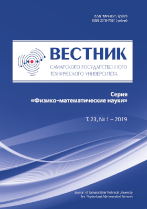|
This article is cited in 2 scientific papers (total in 2 papers)
Differential Equations and Mathematical Physics
The Riemann method for equations with a dominant partial derivative (A Review)
A. N. Mironovab, L. B. Mironovaa, J. O. Yakovlevab
a Kazan Federal (Volga Region) Federal University,
Yelabuga Institute,
Yelabuga, 423600, Russian Federation
b Samara State Technical University, Samara, 443100, Russian Federation
(published under the terms of the Creative Commons Attribution 4.0 International License)
Abstract:
This review article is devoted to a class of linear equations with a dominant (leading) partial derivative of the form $(D+M)u=f$, where $Du$ is a mixed partial derivative, and $M$ is a linear differential operator containing the derivatives of the function $u$ obtained from $D$ by discarding at least one differentiation. We can point out the structural similarity of such linear equations with linear ordinary differential equations. We present the Riemann method for linear equations with a dominant partial derivative, which is a natural generalization of the well-known Riemann method for a second-order hyperbolic equation with two independent variables.
The article deals with the main provisions of the theory developed for the equation with the dominant partial derivative of the general form, allowing the interested reader to apply the obtained results to the task that interests him. The definition of the Riemann function as a solution of the Volterra integral equation is given. The main differential identity is discussed, and the process of obtaining a formula for solving the Cauchy problem in terms of the Riemann function by integrating the specified identity over the corresponding domain in $n$-dimensional space is demonstrated. An example of constructing a solution to the Cauchy problem for the third-order equation is given.
The Riemann method is described below for a fairly wide class of linear systems of hyperbolic equations (including those with multiple characteristics). This method is ideologically very close to the Riemann method for linear equations with a dominant partial derivative.
Applications of the Riemann method to the study of new problems for partial differential equations are discussed. In particular, using the Riemann method, the correctness of new boundary value problems for factorized hyperbolic equations is proved, the solvability of integral equations with partial integrals is investigated, and a certain modification of the Riemann method allows us to develop the Riemann–Hadamard method for Darboux problems. The explicit representation of solutions of hyperbolic systems in terms of the Riemann matrix allows us to study new boundary value problems, in particular, problems with the assignment of normal derivatives of the desired functions on the characteristics, problems with conditions on the entire boundary of the domain, and Darboux problems.
The Riemann method described here for linear equations with a dominant partial derivative is obviously transferred to matrix equations. In this regard, some cases are indicated when the Riemann matrix is constructed explicitly (in terms of hypergeometric functions) for such matrix equations.
The paper provides a review of the literature, briefly describes the history of the development of this direction in Russia and in foreign countries.
Keywords:
Riemann method, Riemann function, Riemann matrix, Cauchy problem, Goursat problem, Darboux problem, partial differential equation with dominant derivative, hyperbolic equation, hyperbolic system, Bianchi equation, Vekua equation, Hallaire equation, Barenblatt–Zheltov–Kochina equation, Boussinesq–Love equation.
Received: March 15, 2021
Revised: April 28, 2021
Accepted: May 11, 2021
First online: May 18, 2021
Citation:
A. N. Mironov, L. B. Mironova, J. O. Yakovleva, “The Riemann method for equations with a dominant partial derivative (A Review)”, Vestn. Samar. Gos. Tekhn. Univ., Ser. Fiz.-Mat. Nauki [J. Samara State Tech. Univ., Ser. Phys. Math. Sci.], 25:2 (2021), 207–240
Linking options:
https://www.mathnet.ru/eng/vsgtu1853 https://www.mathnet.ru/eng/vsgtu/v225/i2/p207
|

| Statistics & downloads: |
| Abstract page: | 638 | | Full-text PDF : | 338 | | References: | 72 |
|



 Contact us:
Contact us: Terms of Use
Terms of Use
 Registration to the website
Registration to the website Logotypes
Logotypes